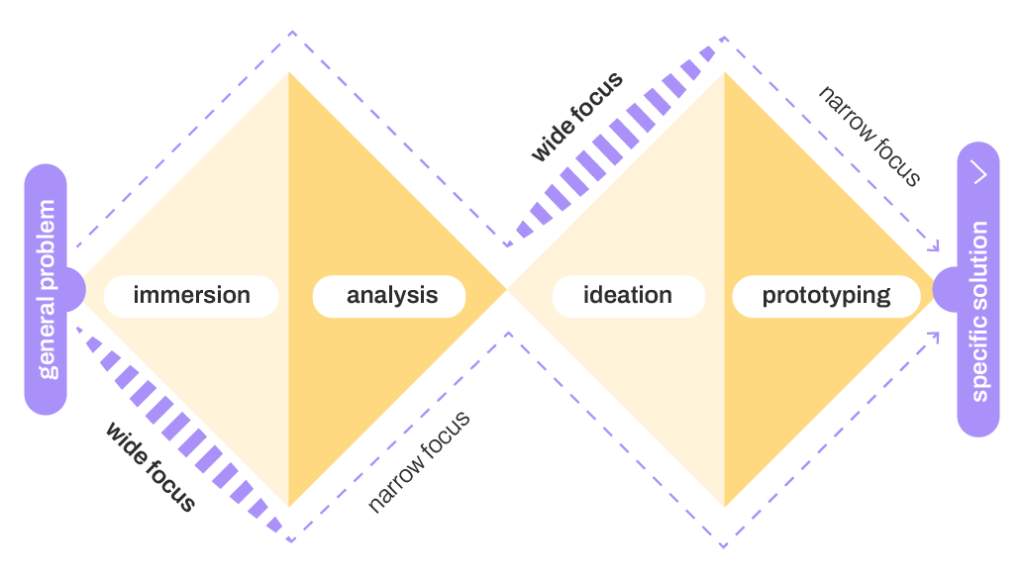Double Diamond: Organize your Innovation Process
Double Diamond is a holistic tool focused in breaking down problems to develop better solutions. Read the full article and find out how to increase the effectiveness of your innovation process.
Double Diamond is the design model that forms the basis for the Design Thinking methodology. It ensures that time and effort are appropriately allocated and generally increases the efficiency and effectiveness of the creative process.
Have you ever been in the middle of a project,, and suddenly a brilliant idea comes into your head that would greatly benefit the solution you and your team are building? Only to realize that incorporating that idea into the project would make hours of previous work redundant? Or perhaps you’re having trouble narrowing down your research and ideas into a focused singular solution?
The Double Diamond is designed to not just help generate innovative ideas and focus effort but put these activities in their proper chronological place. This makes sure your team is never retracing their steps, throwing away good ideas, or losing focus.
What is the Double Diamond, and how does it tie into Design Thinking
The Double Diamond was created in 2004 by the British Design Council, a non-profit institution in the United Kingdom. The Design Council researches on and develops programs related to design and social innovation in business.
They use the Double Diamond process as one of their core methodologies, allowing them to widen their focus to generate research insights/ideas and narrow their focus on determining underlining problems and solutions.
Here is an elementary diagram to illustrate why the shape of the DD is intrinsic to its function:

Immersion & Analysis
The idea behind the Double Diamond is simple and effective. The first two stages of the Design Thinking process are Immersion and Analysis. These two steps are a preamble to the actual solution design process, encapsulated within their own diamond.
In the Immersion phase, the main goal is research, and in that respect, you can never have too much information to go off of. You want to widen your focus to all aspects of the problem at hand, even areas that might be considered adjacent or only partially related. The motto for the “left halves” of each diamond is “the more, the merrier.”
On the other hand, analysis is the process of extracting insights from information. You want to narrow your focus and pinpoint the underlying pains and needs driving this problem. Sometimes this might entail discovering an entirely new problem (a “root problem”). You want to cut away the chaff and determine which information is actually crucial to resolving these pains and satisfying those needs. The driving force behind the “right halves” of the diamonds is “refinement.”
Now that the first diamond is complete, it’s time to move on to Ideation and Prototyping. These are less about understanding the problem and more about finding a solution.
Ideation
The Ideation phase is where all your good, bad, and crazy ideas come into place. With all of the insights generated from Analysis at your fingertips, it’s time to come up with as many ideas as humanly possible. You never know when some crazy idea will give way to groundbreaking innovation, so it’s best not to discard ideas or dissuade team members from thinking outside of the box.
Prototyping
Once you have more ideas than you know what to do with, it’s time to do something with them. The prototyping stage is where your team will cluster ideas together and decide what to actually run with as your solution to the problem. You want to narrow your view once again and focus on one solution at a time, building a prototype as quickly as you can and testing it out in real-life scenarios to see if they hold water. Failing fast is the quickest way to determine which ideas are innovative, and which are just plain crazy.
The MJV Way: Hacking the Double Diamond
Again, this definition is highly simplistic and only just scratches the surface of how the Double Diamond can be used within Design Thinking. Many more activities, frameworks, methodologies, tools, and concepts go into each phase, and you could be here all day just learning about one step in-depth.
Hopefully, this explanation helps you understand why the DD is shaped the way it is and how this design model is engineered to help teams stay on track while exploring root problems and possible solutions.
While these phases within the Double Diamond were titled after the four steps of the Design Thinking methodology, the DD can be used in conjunction with any process. You can think of the four parts as Discover, Define, Develop, and Deliver in more broad terms.
It is also important to remember that the Design Thinking process in general is very flexible, and won’t necessarily follow all four steps for every client and problem. Sometimes the process can also be done “out of order” so to speak, it all depends on what your client or project is demanding from your team. Sometimes you’re just doing the research to then hand it off to a development team. If the experiment itself IS the project, then sometimes you’ll be prototyping before analysis.
The nuances involved in implementing the Double Diamond and even incorporating it in a non-DT environment are all things that come with practice and innovation experience. If you’re interested in getting to know more about these niche applications and understanding the different ways in which the DD and DT can work together, why not check out our other content here?
Organizing the creative process: why use the Double Diamond?
We’ve touched on the benefits of the Double Diamond design model throughout this article, but it’s worth reviewing to understand what it can really provide for your team and projects.
The main benefit of the DD is by far it’s flexibility. The method fits into the four steps of Design Thinking so well that it wouldn’t be crazy to assume that the model was built specifically for it. While it is indeed a perfect fit, that isn’t the limit to DD’s applications. In general it can be applied to ANY project in which a team is looking for a solution to a problem.
Another benefit relates directly to the second stage of the first diamond, the Definition stage. More often than not, clients aren’t entirely certain as to the root cause of problems within their organization. Many times, the problems companies experience are simply the symptoms of a much deeper issue. The purpose of the Definition stage is to understand the data gathered in Discovery, and a common side effect of this process is discovering a new problem, the real problem. This allows your solutions to become more than just symptom soothers and turn into real cures for underling issues.
Being a designer in any industry can have it’s own unique challenges. A program designer will face completely different issues as opposed to a marketing designer. But no matter the context you find yourself in, when you need to find a creative and innovative solution to a problem, having a framework from which to generate ideas and action plans is a universal necessity, and it’s one that the Double Diamond solves in effortless fashion.
Final words of advice
When it comes to innovation and general business success, we’ve come to realize that there is one universal truth: if you want to go fast, go alone, but if you want to go far, go together.
Teamwork and cooperation are a Designer’s bread and butter. Regardless of your corporate context and experience, a fresh pair of eyes and ears can make all the difference when it comes to designing new innovative solutions to persistent challenges.
If you’re thinking about implementing new frameworks, such as the Double Diamond, technologies, and methodologies in your business and are uncertain about how and where to start, why not reach out to one of our consultants? Remember, you don’t have to go it alone.
If you want to check out complementary content, read our Ebook as well: Jobs to be Done: Your market discovery guide to unlocking business opportunities.

